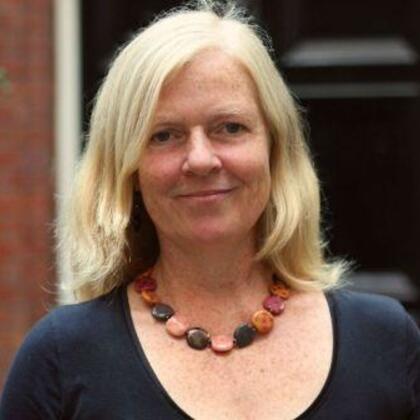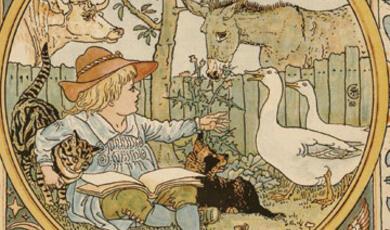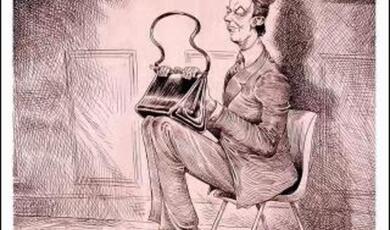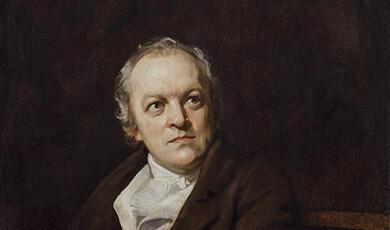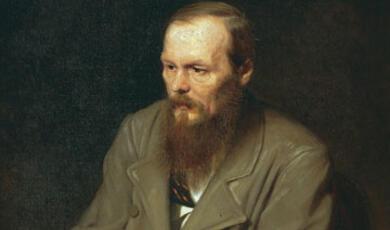Poetry & Immortality: John Keats' 'Ode to a Nightingale'
Share
- Details
- Text
- Audio
- Downloads
- Extra Reading
‘Thou wast not born for Death! immortal bird/ No hungry generations tread thee down.’ Keats’ ‘Ode to a Nightingale’ contains these curious lines. How can a bird be ‘immortal’? The poem is partly about immortality, but how does its complex poetic web work?
Download Text
12 May 2015
Poetry and Immortality: John Keats’
Ode to a Nightingale
Professor Belinda Jack
Good evening – and welcome. This is the second of four lectures that I am giving on poetry, which follow four which I gave on the novel. In addition to analysing some well-known poems, I want to show how the different literary genres lend themselves to different kinds of exploration – essentially of the human condition. In my last lectures I considered ideas of remembering and remembrance in relation to Gray’s famous Elegy. Tonight I would like to explore ideas of immortality and indeterminacy in Keats’s celebrated Ode to a Nightingale. The music you heard just now was Oliver Messiaen’s, ‘Le Réveil des oiseaux’. Messiaen was a twentieth century composer who was fascinated by birdsong, notating bird songs worldwide and incorporating birdsong transcriptionsinto his music. This by way of illustration of the importance of birdsong not only to poetry, but to music too.
John Keats, one of the most famous English Romantic poets was born on October 31, 1795, in London. His father was livery-stable keeper and John Keats (hereafter, just ‘Keats’) was the oldest of four surviving children. His father died when Keats was eight years old and his mother died when he was fourteen, of tuberculosis. His maternal grandmother found him two guardians, both London merchants, Richard Abbey and John Rowland Sandell. When Keats was fifteen, Abbey withdrew him from the Clarke School, Enfield, and sent him as an apprentice to Thomas Hammond, a surgeon and apothecary. Keats lodged in the attic above the surgery at 7 Church Street, Enfield (then Middlesex), until 1813. After his apprenticeship, Keats registered as a medical student at Guy's Hospital. Within a month, he was accepted as a ‘dresser’ at the hospital, the equivalent of a junior house surgeon today. It was a rapid promotion suggesting considerable aptitude for medicine. But Keats had not given up his writing and became increasingly frustrated by the time-consuming nature of his job as a doctor. The earliest poem by Keats that survives was written in 1814, when Keats was nineteen years old. He was clearly set not on medicine but on being a poet. His brother George wrote that John ‘feared that he should never be a poet, & if he was not he would destroy himself’. In 1816, Keats was awarded his apothecary’s licence which gave him the right to practice as an apothecary, doctor and surgeon. But before the year was out he had announced to his guardian that he had resolved to give up medicine and live as a poet. One of a growing number of editor and poet friends to help him was Leigh Hunt, in turn a friend of Byron, Shelley, and Wordsworth. Hunt published The Examiner and in May 1816, he agreed to publish Keats’ sonnet, ‘O Solitude’. Keats’s first volume of poetry, entitled simply Poems by John Keats, was published in 1817. Endymion, a four-thousand-line allegorical romance based on the Greek myth of the same name, appeared the following year. Two of the most influential critical magazines of the time, the Quarterly Review and Blackwood’s Magazine, attacked the collection, referring to the poetry of Hunt’s literary circle as ‘the Cockney school of poetry’. In Blackwood’s, Keats’s poem was described as nonsense and the magazine advised Keats to give up writing poetry altogether. Another critic quipped that the book‘might have emerged in Timbuctoo.’ Keat’s publishers, Charles and James Ollier, apparently felt ashamed of the book and Keats immediately approached Taylor and Hessey on Fleet Streetwho took him on. Unlike the Olliers, Taylor and Hessey were obviously excited by Keats's work and within a month of the publication of Poems they were planning a new Keats volume and even paid him an advance. Taylor and Hessey were important publishers of poetry whose list eventually included Coleridge, Hazlitt, Clare, Hogg, Carlyle and Lamb. His new publishers’ confidence in him must, in turn, have been a great boost to his own confidence.
In the summer of 1818, Keats set out on a walking tour in Northern England and Scotland. On returning home he committed to caring for his brother, Tom, who was suffering from TB. Tom died on December 1, 1818. Less than a year later, in the autumn of 1819, Keats himself was diagnosed with TB. From February 1820 on, he referred to his life as a ‘posthumous existence.’ But despite his illness – or perhaps with a new sense of urgency - this was a period of remarkable creativity and in July 1820, he published his third and best volume of poetry, Lamia, Isabella, The Eve of St. Agnes, and Other Poems. In addition to the title poems it contains three poems often considered among the finest in the English language, ‘Ode on a Grecian Urn’, ‘Ode on Melancholy’, and the subject of tonight’s lecture, ‘Ode to a Nightingale.’ The book was enthusiastically received.
That autumn, Keat’s doctor recommended that he spend the winter in a warmer climate than England and he and a painter friend, Joseph Severn, travelled to Rome. Keats died in Italy on February 23, 1821. He was twenty-five, and was buried in the Protestant cemetery in Rome.
I have had to be highly selective in this mini biography of Keats. It could be argued that his two lovers, particularly for Fanny Brawne whom he met when he was nursing his brother, were also of considerable significance to him as a poet but I have concentrated rather on those aspects of his biography which might explain his extraordinary capacity to render the intensity of our knowledge of our mortality – and thus conception of immortality – which lies at the heart of the Ode: the early deaths of both his parents, his time living in the attic of the surgeon’s shop and no doubt very aware of pain and death below, his own experiences as a hospital doctor, Tom’s death to TB and the knowledge of his own approaching death, also from TB.
But the Ode is by no means a cry of hopelessness, or anger, or despair. So how should we read it? We might want to be guided in part by Keats’s own notion of poetry:
‘I think Poetry should surprise by a fine excess and not by Singularity – it should strike the Reader as a wording of his own highest thoughts, and appear almost a remembrance’. Maurice Buxton Forman (hereafter MBF), 48 (116).
In other words Keats believed that the reader or listener should be unaware of the artifice, of particular poetic techniques, and rather engage with the poem as a whole, as ‘a fine excess’. It should strike the reader as strangely familiar, ‘almost a remembrance’ of his or her own feelings, experiences, and thoughts. So what do we know of the poem’s origins?
It was probably written in the late spring of 1819. It was most likely composed in Hampstead where Keats was sharing a house with his friend, C.A. Brown. Brown famously wrote: ‘In the spring of 1819 a nightingale had built her nest near my house. Keats felt a tranquil and continual joy in her song; and one morning he took his chair from the breakfast-table to the grass-plot under a plum-tree, where he sat for two or three hours. When he came into the house, I perceived he had some scraps of paper in his hand, and these he was quietly thrusting behind the books. On inquiry, I found those scraps, four or five in number, contained his poetic feelings on the song of the nightingale’.
Recording of Nightingale’s Song
Some commentators have considered Brown’s account overly proprietorial but it may well give us some insight into the creative moment which was the catalyst for the poem. We also know that on 11 April 1818, Keats went for a long walk on Hampstead Heath with Coleridge, by then a well-established poet and some years older than Keats. In a letter to his brother George, Keats described how the two of them had talked about ‘a thousand things,... nightingales, poetry, poetical sensation, metaphysics.’ It is unlikely that the poem came as spontaneously to Keats as Brown suggested.
Before we hear a reading of the poem and embark on an exploration of it, it is worth considering the ‘ode’ as a type of poem.
The ode (from Ancient Greek: ᾠδή ōidē), is a type of lyrical stanza. A classical ode is structured in three major parts: the strophe, the antistrophe, and the epode.
The English ode is a lyrical stanza in praise of, or dedicated to, someone or something, that captures the poet's attention, or serves as poetic inspirationfor the ode. The earliest English proponent of the ode in English was Edmund Spenser. In the seventeenth century, the most important odes were by Abraham Cowley. A better understanding of the classical metre of Pindaric form of the ode in the eighteenth century led to something of a revival. Thomas Graywrote a number of Odes based on Pindar’s form. Around1800, Wordsworth revived Cowley's Pindaric for one of his finest poems, the ode, Intimations of Immortality(Inspired by Keats’s Ode to a Nightingale). Others who also wrote odes include Coleridge and Shelley. But the greatest odes of the nineteenth century are arguably Keats's: Ode on Melancholy, Ode on a Grecian Urn, Ode to Psyche, To Autumn, and Ode to a Nightingale. After Keats, there have been comparatively few major odes in English. One major exception is W.H. Auden who wrote a poem simply entitled, Ode which satirizes people's ignorance over the reality of war. In an interview, Auden said that he had first intended to entitle the poem My Silver Age as a parody of the idea of the Imperial Golden Age.
The English ode's most common rhyme scheme is ABABCDECDE and Keats’s poem conforms to this pattern.
There are eight stanzas and each has ten lines. So why did Keats opt for the ode form?
Beth Lau points out: ‘As several critics have noted Keats’ use of the ode in 1819 grew out of his desire to discover a form that would allow more room to develop ideas than the restricting sonnet, but less freedom to range in than the shapeless verse epistles or long, open-couplet poems of his youth. (Beth Lau, ‘Associationism and “Ode to a Nightingale”’, Keats Shelley Journal.)
David Perkins has also demonstrated the function of the strong central symbol of the nightingale helps to focus the train of thought. (David Perkins, The Quest for Performance (Cambridge, Mass;Harvard University Press, 1959), pp. 242-245)The ode form and the strong central symbol combine to allow Keats to fulfil his ambition: to write ‘independently and with judgment’. What exactly did he mean by this?
Keats believed in the concept of ‘Negative capability’. By this he meant an ideal of open-mindedness, of ‘let[ting] the mind be a thoroughfare for all thoughts’. He did not want his mind to ‘irritabl[y] reach[ing] after fact and reason’, ‘hungering… after truth’, or ‘always trying at it’. (Letters, II, 213; I, 193, 185). We should be able, especially if we are poets, to be ‘capable of being in uncertainties, Mysterie, doubts’ and of ‘remaining content with half knowledge’ (Letters, I, 193-4). It is this idea of ‘half knowledge’, or indeterminacy’ that I would like to inform my commentary on the ode.
But first let us hear a reading of it.
[http://downloads.bbc.co.uk/arts/romantics/audio/mp3/keats_ode_to_a_nightingale.mp3]
The speaker opens with a declaration of his own heartache. He feels numb, as though he had taken a drug (‘hemlock’ (a poisonous plant which produces death by paralysis), ‘opiate’, ‘Lethe’ (a river of the lower world from which the shades (spirits of the dead) drank, and thus obtained forgetfulness of the past)), moments earlier. His addressee, ‘thou’ (line 7) is a nightingale that he can hear singing in the forest. His ‘drowsy numbness’ is not a function of envy of the nightingale’s ‘happiness’, but rather from sharing it too wholeheartedly. The speaker is ‘too happy’ because the nightingale ‘singest of summer’, hidden in a plot of ‘green’ and ‘shadows’. The alliteration – plenty of it in the poem - ‘singest of summer’ reflects the ‘ease’ with which the nightingale sings.
In the second stanza, the speaker longs for fine wine, ‘a draught of vintage’ and the slow but steady oblivion it might bring (‘fade away’). ‘Sunburnt mirth’ is a wonderful synesthetic expression eliding a feeling or look, ‘sunburnt’, with an abstract noun denoting good cheer, ‘mirth’. Synaesthesia, [define], and ‘half-knowledge’.
The image of the ‘beaded bubbles winking at the brim’ is much admired. The alliteration of ‘b’s captures the action of sparkling wine and suggests onomatopoeia.? The ‘winking’ is suggestive of bubbles forming and bursting like an eye opening and shutting.
In the third stanza, he declares his desire to ‘fade far away’, ‘dissolve and quite forget’. What he wants to leave behind is the intensity of human suffering. It will ‘dissolve’, lose its substance, and be forgotten - ‘weariness’, ‘fever’, ‘fret’, the ‘palsy’ of the old. The nightingale, ‘thou among the leaves’ has never known these and has no consciousness of ageing and death while the speaker knows that youth does not last, it ‘dies’, and Beauty fades: ‘Beauty cannot keep her lustrous eyes’. Beauty is personified here and her ‘eyes’ are singled out. Of course it is our eyes that behold beauty. Again there is an indeterminacy that suggests ‘half-knowledge’.
In the fourth stanza, the speaker invites the nightingale to fly away - and he will follow. This will not be facilitated by wine (‘Not charioted by Bacchus and his pards’ (‘leopards’)), but by poetry. He sets up an opposition between the ‘viewless (i.e. invisible’) wings of Poesy’ and the ‘dull brain’ which ‘perplexes and retards’. Rational thought tethers the imagination to the known and familiar but this brings no revelation (perplexes). [Re-cap ‘Negative capability’ - an ideal of open-mindedness, of ‘let[ting] the mind be a thoroughfare for all thoughts’. He didn’t want his mind to ‘irritabl[y] reach[ing] after fact and reason’, ‘hungering… after truth’, or ‘always trying at it’. (Letters, II, 213; I, 193, 185). We should be able, especially if we are poets, to be ‘capable of being in uncertainties, Mysterie, doubts’ and of ‘remaining content with half knowledge’ (Letters, I, 193-4).] Weight is associated with the mundane, in turn associated with negative states of feeling, e.g. ‘leaden-eyed despairs’ in the third stanza.
And already, by the fifth line of the fourth stanza, the speaker has caught up with the nightingale, ‘Already with thee!’ The night is moonlit and starry (again there is personification - ‘Queen Moon’, ‘starry Fays’ (‘fairies’)),although there is ‘no light’ except when the breezes cause the trees to part (‘Save what from heaven is with the breezes blown’). So there is both ‘no light’ and yet some light. In the fifth stanza, the speaker addresses the nightingale only by implication. There is no second person pronoun (‘thou’, ‘thee’, ‘thy’); these occur in all the other verses. ‘I cannot see’ the speaker declares, but ‘in embalmed darkness’ he can guess ‘what flowers are at’ his feet: white hawthorn, eglantine, violets, and the musk-rose. (Lines 43-49 appear to echo Shakespeare's A Midsummer Night's Dream, II.i.249-52 The Riverside Shakespeare, ed. G. Blakemore Evans and J. J. M. Tobin, 2nd edn. (Boston: Houghton Mifflin, 1997):
I know a bank where the wild thyme blows,
Where oxlips and the nodding violet grows,
Quite over-canopied with luscious woodbine,
With sweet musk-roses and with eglantine ...
But in Keats’s poem, the stanza is one of presences and absences, or life and death, of indeterminacy. Alone, the speaker experiences the intense poetic epiphany. He does not need ‘to see’, in order to imagine, or to see ‘in his mind’s eye’, as the expression goes. Perhaps the reverse: we instinctively close our eyes when trying to imagine.
Some of the structure of the poem can be accounted for in terms of antithetical pairings: pain/joy, intensity of feeling/numbness of feeling, life/death, mortal/immortal, the actual/the ideal, and separation/connection. And the ‘half-knowledge’ of which Keats spoke, is suggested by the indeterminacy, the space between these pairings.
The speaker may be alone, in ‘embalmed’ darkness, an image of death. This then leads to the contemplation of the attractions of death of which the speaker tells in stanza 6: ‘I have been half in love with easeful Death’ (line 52). There is a hint of irony here as the nightingale sang, in the first stanza, ‘in full-throated ease’. This moment of ‘ecstasy’, listening to the artless exquisiteness of the nightingale’s song strikes him as an ideal moment at which to die: ‘To cease… with no pain,/While thou art pouring forth thy soul’. And the speaker would die in the knowledge that the nightingale’s song would not cease, even if he were no longer able to hear it. There is an ambiguity, indeterminacy, about the word ‘Still’ in the penultimate line of the sixth stanza, ‘Still wouldst thou sing’. The ‘still’ could either denote temporal continuity or physical lack of movement. The first suggests immortality while the second death (mortality). The idea of the speaker’s mortality, in contrast to the nightingale is introduced and then expanded upon in the famous first two lines of the seventh stanza:
Thou wast not born for death, immortal Bird!
No hungry generations tread thee down;
Extracts from article, ‘The Immortality of the Natural…’
I’d like to suggest a further possibility. Poetry is constantly being re-written. Poets borrow from the dead poets and Keats knew that others would in turn borrow from him after his death. Could not the poets of the future be the ‘hungry generations’ who will ‘tread down’ the poetry of the dead? But the nightingale’s song retains its integrity. The very same song goes on being sung by generation after generation of nightingale. In this sense it is ‘immortal’. To substantiate this reading I contacted Professor Christopher Perrins, from the Department of Zoology at Oxford University to ask whether it was likely that the song of the nightingale had changed over time. Could it be that the birdsong we hear today is exactly the same as the song Keats heard? This is his reply:
I am afraid that this is not a very helpful reply, but I suppose no one really knows the answer to your question. My guess is that the answer is that we are hearing the same song that Keats heard.
However, without good quality recordings, I do not see how anyone could answer your question.
My guess would be that it had not changed. Small local differences have been noticed between birds of the same species which sing in different habitats; this includes those which sing in urban areas being slightly different from those in rural habitats. But I know none that relate to nightingales.
Christopher Perrins
The voice he hears singing (line 53) has always been heard, by emperors and clowns, and by the Biblical homesick Ruth (the corn is ‘alien’ because Ruth was not an Israelite but a Moabitess, gleaning in the barley fields of Judah (Ruth 2:1-2). In the eighth and final stanza, the word ‘forlorn’ tolls like a bell to restore the speaker from his preoccupation with the nightingale back to himself, ‘my sole self’, in lines reminiscent of Gray’s Elegy that we explored a few weeks ago. This means, of course, that he is alone but ‘sole’ is a homophone for ‘soul’. In the sixth stanza, it was the nightingale’s: ‘Thou art pouring forth thy soul’. Now it is the ‘soul’ of the poet that is alluded to. The ‘fancy’, that is the imagination, cannot sustain the speaker’s ‘vision’. The ‘plaintive anthem’ that is the nightingale’s song now ‘fades’ and ‘’tis buried deep/In the next valley-glades’. The ‘buried’, picking up on the idea of ‘embalmment’ of the fifth stanza – both referring to death. The verb ‘fade’ has occurred three times, denoting the movement from presence to absence which mirrors that of life to death. The ‘half-knowledge’ and the indeterminacy are intimately bound up with the idea of ‘fading’, moving from one state to another – from light to shade, from day to night, from life to death and so on, but imperceptibly undermining the all-embracing antithetical pairs. The bird’s ‘anthem fades’, not the bird. In fact there is an important distinction to be made between the speaker’s ‘half-knowledge’ and the bird’s ontological status.[‘Ontology’ is the philosophical study of the nature of being, becoming, existence, or reality, as well as the basic categories of being and their relations]. As Andrew J. Kappel points out in an article entitled ‘The Immortality of the Natural: Keats ‘Ode to a Nightingale’ (EHL, John Hopkins, vol. 45, 2 (Summer, 1978) pp.270-284), ‘The trajectory of the bird’s withdrawal at the end of the poem is an indication that its ontological status as a natural being is maintained to the end. As it withdraws, it moves from one natural setting to another, never ventures outside nature and seems, indeed, to retreat ever more deeply into the natural world:
Thy plaintive anthem fades
Past the near meadows, over the still stream,
Up the hill-side; and now ‘tis buried deep
In the next valley-glades.
The use of hyphens ‘hill-side’ and the more original ‘valley-glades’, again suggests ‘half-knowledge’. Is a ‘hill-side’ the same as the side of a hill? Are the ‘valley-glades’ the same as ‘glades of the valley’?
The poem ends with two questions: was what the speaker has described ‘a vision, or a waking dream’, is he ‘[a]wake or asleep’?
It would be a great irony if Keats’s great exploration of immortality had itself faded out of human consciousness. What of its posterity? How has it done – in relation to the nightingale’s immortal song which we heard earlier? If you type ‘Ode to a Nightingale’ into Google 1,250,000 results pop up within seconds. Keats's influence was strong in the nineteenth century and his poetry resonates into the twentieth century - poets like Wallace Stevens, T.S. Eliot, and countless others.
As I mentioned earlier, Keats died at the age of 25 and was buried in the Protestant cemetery in Rome. Two of his friends added the following epitaph:
This Grave
contains all that was Mortal
of a
Young English Poet
Who
on his Death Bed
in the Bitterness of his Heart
at the Malicious Power of his Enemies
Desired
these Words to be
engraven on his Tomb Stone:
Here lies One
Whose Name was writ in Water. 24 February 1821
They added these lines to register their deep disappointment with the cruel critical reception of Keats's work. Hunt blamed his death on the Quarterly Review's derisive attack of "Endymion". Byron retaliated with the following lines in his narrative poem Don Juan:
'Tis strange the mind, that very fiery particle
Should let itself be snuffed out by an article.
(canto 11, stanza 60)
Keats was snuffed out in his youth but the poem has remained remarkably popular. To finish, I would like to point out some of the features of the poem which make it so effective. The poem is wonderfully good at creating a sense of mood. At the start of the poem the thudding alliteratives, d’, ‘p’ and ‘m’ evoke the dull ache that the poet describes. In the second half of the stanza, on the other hand, light assonantal [the repetition of vowel sounds to create internal rhyming] sounds are created by words such as ‘light’ and ‘Dryad’. There is a sensual, lingering quality in the assonantal sounds ‘beechen’, ‘green’ and ‘ease’ when the poet is evoking the joyousness of the nightingale. In terms of pace one can compare the brisk and ecstatic vitality of the second stanza which skips along at speed, with the heaviness and monotony of the third stanza. There is a marked concentration of sense impressions and frequent use of synaesthesia. In stanza 1, for example, the `plot' where the bird sings is itself `melodious' and the song contains `summer': the visual evokes the aural and the aural the visual. In stanza 2, the taste of wine is evoked by means of colour, action, song and sensation. In stanza 5, `I cannot see what flowers are at my feet, / Nor what soft incense hangs upon the boughs', the suggestion that the incense could be seen emphasises the materiality and headiness of the perfume: it is so strong it seems tangible. It is the processes and movement of the poet's mind that are the central focus of `Ode to a Nightingale', and the personal `I' is very foregrounded.
It was this intensely personal quality of the poem married to its musical effects that F Scott Fitzgerald particularly admired. These are brought out exceptionally well in his reading of the poem. . F. Scott Fitzgeraldwas a great admirer of the poem and the title of one his most famous novels, Tender is the Night, comes from this poem.
So we’ll finish listening to Fitzgerald’s reading which is – movingly – incomplete. He died the same year as the recording, age 44 – of TB.
Thank you.
© Professor Belinda Jack, May 2015
This event was on Tue, 12 May 2015
Support Gresham
Gresham College has offered an outstanding education to the public free of charge for over 400 years. Today, Gresham College plays an important role in fostering a love of learning and a greater understanding of ourselves and the world around us. Your donation will help to widen our reach and to broaden our audience, allowing more people to benefit from a high-quality education from some of the brightest minds.


 Login
Login



